- Home
- Simon Winchester
The River at the Centre of the World
The River at the Centre of the World Read online
PENGUIN BOOKS
THE RIVER AT THE CENTRE OF THE WORLD
Simon Winchester was born and educated in England, has lived in Africa, India and China, and now lives in the Berkshire Hills of western Massachusetts. Having reported from almost everywhere during more than thirty years as a foreign correspondent, he now contributes to a variety of American and British magazines and makes regular broadcasts for the BBC.
Simon Winchester's other books include Outposts: Travels to the Remains of the British Empire; Korea: A Walk through the Land of Miracles; The Pacific; Pacific Nightmare, a fictional account of the aftermath of the Hong Kong hand-over; Prison Diary, Argentina, the story of three months spent in a Patagonian jail on spying charges during the Falklands war; The River at the Centre of the World – A Journey up the Yangtze, and Back in Chinese Time; the number-one international bestseller The Surgeon of Crowthorne; and The Map that Changed the World, which tells the extraordinary story of William Smith, pioneering geologist of the British Isles.
SIMON WINCHESTER
The River at the Centre of the World
A Journey up the Yangtze,
and Back in Chinese Time
PENGUIN BOOKS
PENGUIN BOOKS
Published by the Penguin Group
Penguin Books Ltd, 80 Strand, London WC2R 0RL, England
Penguin Putnam Inc., 375 Hudson Street, New York, New York 10014, USA
Penguin Books Australia Ltd, 250 Camberwell Road, Camberwell, Victoria 3124, Australia
Penguin Books Canada Ltd, 10 Alcorn Avenue, Toronto, Ontario, Canada M4V 3B2
Penguin Books India (P) Ltd, 11 Community Centre, Panchsheel Park, New Delhi – 110 017, India
Penguin Books (NZ) Ltd, Cnr Rosedale and Airborne Roads, Albany, Auckland, New Zealand
Penguin Books (South Africa) (Pty) Ltd, 24 Sturdee Avenue, Rosebank 2196, South Africa
Penguin Books Ltd, Registered Offices: 80 Strand, London WC2R 0RL, England
www.penguin.com
First published in the USA by Henry Holt and Company Inc. 1996
First published in Great Britain by Viking 1997
Published in Penguin Books 1998
23
Copyright © Simon Winchester, 1996
All rights reserved
The moral right of the author has been asserted
Except in the United States of America, this book is sold subject to the condition that it shall not, by way of trade or otherwise, be lent, re-sold, hired out, or otherwise circulated without the publisher's prior consent in any form of binding or cover other than that in which it is published and without a similar condition including this condition being imposed on the subsequent purchaser
ISBN: 978-0-14-193790-8
This book is dedicated to
Lucy and David Tang –
a small token of a great delight
Contents
Map of China
In Gratitude
Author's Note
Prelude
1 The Plan
2 The Mouth, Open Wide
3 The City Without a Past
4 The First Reach
5 City of Victims
6 Rising Waters
7 Crushed, Torn and Curled
8 Swimming
9 A New Great Wall
10 The Shipmasters' Guide
11 The Foothills
12 The Garden Country of Joseph Rock
13 The River Wild
14 Harder Than the Road to Heaven
15 Headwaters
Suggestions for Further Reading
Index
In Gratitude
My thanks go first to two people I have never met, Andrea and Harry Crane of Chicago. It was their unanticipated kindness that led me to meet the extraordinary and enthusiastic Wan-go Weng in his house in remotest New Hampshire, and it was he who in turn showed me the Wang Hui picture called the Ten thousand li Yangtze – the picture that truly set this journey in train. To all three, connected to each other only by the faint incandescent trails of digital electronics, I owe a very great deal.
A journey of this scale demands the very best maps and I am glad to count as my good friend Francis Herbert, the curator of the Map Library at the Royal Geographical Society in London: he found for me some of the best old French maps and portolanos of the Upper Yangtze, and then led me to other sources of good modern charts – the firm of Brupacher Landkarten in Switzerland, who supplied me with the frighteningly excellent Soviet General Staff maps of western China, and a young lawyer named Julie Jones of the Defense Mapping Agency in Washington, D C, an agency which – after a tussle with officials that Ms Jones gamely fought on my behalf – came up with all the relevant sheets from the normally classified map series known as Joint Operations Graphics.
David Yiu, the ebullient and unforgettably generous figure behind Regal China Cruises, then helped me to make a number of reconnaissance trips along the navigable reaches of the river. His three vessels proved superbly comfortable refuges from which I could plan journeys by more rudimentary transport and one of them acted as a floating hotel for me during my frequent visits to Shanghai. If there were ever moments when my enthusiasm for continuing the voyage wavered, it was David's eagerness and sense of fun that always managed to restore it.
I cannot hope to express my gratitude to the young woman whom current Chinese circumstance obliges me to disguise with the English name of Lily. This courageous and unflappable Manchurian, who rightly hesitated long before deciding to accompany me, turned out to be absolutely central to the successful completion of the journey. The fact that the trip up the great river was as much an adventure for her as a Chinese citizen, to whom the Yangtze means so much, as it was for me as a curious foreigner perhaps offers some practical measure of my thanks for her participation. As I say elsewhere, sad reality makes it too risky to identify her more fully than I do, but she knows who she is, and I hope that when she reads these words she will understand a little more easily how very real and lasting is my admiration for her.
Among the others to whom I owe thanks in varying measure are these following, along with very many more unnamed people for whom identification in China would be similarly perilous. I was helped enormously by: Richard Bangs of Mountain Travel-Sobek in California; Betty Barr of Fudan University in Shanghai; David Brown of the Royal Navy Historical Branch in London; Jeremy Brown of Jardines; Peter Cann of the University of Pennsylvania, a specialist in Pearl Buck; Daniel Desmond, General Manager of the Holiday Inn, Lhasa; Dave Fairty and Anne McAndrew of Backcountry Outfitters in Kent, Connecticut, who sent me off properly clothed and shod; Simon Featherstone, the current British Consul-General in Shanghai; William Goodman of the Ertan Dam Project on the Yalong River; my old friend Richard Graham, who gave valuable time during his own interesting moments spent running the Barings office, post-trauma, in Shanghai; Charlotte Havilland of Swires; Huang Guo Guang, who plied me with strong drink at the Wuliangye Distillery, Yibin; Michael Ingram of Monenco Agra in Ottawa, who had much useful to say about the new dam, both when we met in Yichang and later in Canada; Penny King at the Asian Music Centre in London, who organized the Nakhi orchestra's successful tour of Britain; Li Shou Kun and Helen Jin of the Yun Ying art gallery in Wuhan; the splendid Julia Liu of the Ramada Hotel in Wuhan; the writer Madeleine Lynn in Hong Kong, who collects arcana from the Yangtze and was happy to share it; Rick Jacobs of Northwest Airlines in Minneapolis; Patrick McCully and Owen Lammers of the International Rivers Network in Berkeley, California; the magnificent Hong Kong medical personality Dr Jake O'Donovan, who made sure that I was able to keep fit and unblistered in the wildest reaches of Tibet; Pam Lo
gan and her colleagues at the China Exploration and Research Society; Ma Jishen, Professor of Archaeology at Sichuan United University, a hugely knowledgeable source about the losses that are to be sustained in the wake of the Three Gorges flooding; the eternally good-humoured Washington writer Rudy Maxa, who accompanied me on an early scouting trip and insisted that I write this book; a number of members of the ill-fated Ken Warren rafting expedition who talked to me anonymously about that extraordinary episode; Professors Suo Lisheng, Yu Kehua and their colleague dam designers at Hohai University in Nanjing; my great friend Iain Orr of the British Foreign Office, who knows much about rivers, islands and China; Cynthia Shiu of Grid Media in Hong Kong, who first brought the world of interactive electronics to the Yangtze by publishing a CD-ROM about it; Professor Lyman van Slyke of Stanford University, who generously gave me material about Cornell Plant and shared his own long experience of writing about the river; the amusing and flamboyant Tao Chang An in Wuhan; Frank and Irene Walker, who when we met had been transplanted from their home in Lochcarron in Wester Ross to the banks of the Yalong River near Panzhihua; Tom Wallace, the editor-in-chief of Condé Nast Traveler, and the magazine's senior editor Gully Wells, who both helped support many of my travels to the region; my former agent Lois Wallace, who helped so ably with the initiation of this book, and my present agent Peter Matson and his colleague Jennifer Hengen at Sterling Lord Literistic of New York; Wang Naili of the Shanghai Tourism Administration; Wen Zi Jian of Jiujiang; my son Rupert Winchester of Hong Kong; Wu Wei, of the People's Insurance Company of China in Panzhihua, who loaned me his car and. his driving skills to take Lily and me to and around Lijiang; Terry Xu of Malone's Café, Shanghai; Xu Xiaoyang in Chengdu, who was inexpressibly kind in a score of ways, and who loaned us a second car to take us from Chengdu to Lhasa and to the upper reaches of the Tuotuo River; the great musicologist Xuan Ke in Lijiang; the Misses Mirra Ye and Lulu Uy and the rest of the public relations staff at the great Portman Shangri-La Hotel, Shanghai; and finally in this list, the first man whom I was to meet officially in China, at the very start of the journey - Mr Zhang Zu Long of the Woosung Supervision Station. He is the official whose task is, among other things, to keep a constant watch, as navigators have done for more than a century and a half, over the highly contentious and historically memorable phenomenon known as The State of the Woosung Bar.
All of these people gave more information, told me stories, offered me help and advice. In the end, though, I interpreted what they said and I wrote the book, and if there are errors, misjudgements or infelicities in the pages that follow, responsibility should be laid squarely at my door, and at mine alone.
Although I had long nurtured the notion of writing about the Yangtze, it was my London agent and friend of many years, Bill Hamilton, who suggested translating the idea into action: my thanks to him for setting me on the trail from the high seas to High Tibet are unqualified. My delight in having Marian Wood as editor at Henry Holt is similarly unbounded: she and her colleagues have shown the greatest diligence during all the phases of the book's creation and production, and I am proud to be associated with them and their work.
Finally it goes almost without saying that a serene and comfortable environment provides a wonderful base for writing a book about a place that is as difficult and distant as China. That Catherine, my wife, was despite her own busy life well able to keep our home cosy and welcoming, and that she put up with my occasional frustration and ill temper, is a measure of what a remarkable woman she is. The making of this book was an endurance test through which she came with flying colours.
Wassaic, New York
November 1996
Author's Note
Generally speaking I have used the pinyin form of the transliteration of the Chinese place-names and personal names that are used in this book. However, since this account deals with the past as well as the present – the Yangtze journey being deliberately chronological as well as topographical – there are occasions when it seemed to me much more suitable to use the old and officially discarded Wade-Giles form.
So although I visit the city of Nanjing, as it is presently known, I also make references to the Rape of Nanking and the Treaty of Nanking. Similarly, the river takes us to the grimy city that is now called Wanxian; but the infamous Wahnsien Incident took place there seventy years ago, and to refer to those remarkable events by the more modern name would make for greater confusion, I believe, than my small lexical inconsistency. In any case the names used in these and other examples sound to the Western ear usually more or less similar: only when the variant forms are very different – Tibet and Xizang, for instance, or Changan and Xian – do I interrupt the narrative to explain.
The name of the river itself is so complex and historically fascinating as almost to justify an entire chapter to itself. From this, however, I spare the reader – with the single caveat that the proper pinyin rendering of Yangtze is actually Yangzi, and the pronunciation, offered very approximately, is rather less Yang-tzee than it is Young-zer. But since the Chinese rarely if ever use either version, I have stuck with the most familiar, albeit barbarian, form.
As to how it became saddled with the non-Chinese name Yangtze – there is more mystery than agreement. Some nineteenth-century references speak of the word meaning ‘Son of the Sea’, while others refer to it as deriving from ‘the Blue River’ – and both of these interpretations are fairly reasonable, given that Chinese and its English transliterations enjoy an almost limitless elasticity. However, the most likely explanation probably results from a mishearing. Early western sailors on the river undoubtedly asked local boatmen for the name of their stream, and these boatmen – who may well have come from, or have been well aware of the great local influence of, the city of Yangzhou, which was then the greatest metropolis in the estuary region (and was where Marco Polo worked in the bureaucracy) – mouthed something to the effect that this was ‘the river of the Yang Kingdom’. Since Jiang is unequivocally the word for river, the combination of mumbling and elision of the words Yang and Jiang could quite possibly, to the untutored ear of a London-born sailor, have come across as Yangtzee-kiang. This name would have been reported back to the ship's captain; it would have eventually found its way into a report: the Admiralty would have issued orders relating to the said-named stream; and thus would geography, cartography and history have been gifted with an enduring new addition.
Common usage has it that a river's left bank or right bank is that which is seen on a downstream journey – the bank that is regarded from the point of view, as it were, of the flowing waters. I have tried to stick to this hydrographers' convention throughout my account. However, since my journeying was intentionally and relentlessly upstream this did produce moments that managed even to confuse me: I would see, from the deck of my upriver ship, a pagoda on the bank that lay on my right side, but I would have to note down that it in fact stood on the bank that, by convention, was actually the river's left. I have in places tried to lessen the confusion by mentioning north or south, or east or west, if doing so seems to clarify the situation; but I have to confess that this didn't always work.
*
The most difficult part of writing any book about the sad situation of contemporary China is not being able – thanks to the present government's unquenchable capacity for cruelty and revenge – to give the real names of many of the participants.
Many of the men and women whom I met along the four thousand miles and many months of this journey said things to me that were well worth including in the narrative; many others helped me in undertaking an expedition that was in no way officially sanctioned, nor even officially known about. I realized when I was writing, even if these people did not, that by relating their comments or the tales of their assistance in this book, I would cause retribution of some unpleasantly imaginative kind to befall them at some untold moment in their various futures. So I have, and with great reluctance, altered several names, and I have rendered deliberatel
y vague one or two – but only one or two – locations.
Of the changes I have been forced to make I am sorriest of all to have to refer to Lily, my trusted guide and mentor, by this invented English name, and not by her real one – which, as well as enjoying the singular merit of being hers, is in its Chinese form very much more lovely, too.
Without Lily this book could not have come about, at least not in its present state. And yet to draw too much attention to her by writing of her as fully as I would like would be to invite a cascade of official wrath which she in no way either deserves or would be in a position to deflect. Lily is a remarkable and courageous young woman, the like of which China should be proud to count among its own. I am sure I am not alone in hoping that young men and women just like her will eventually find some way to inherit the management of their vast country, and thus one day, perhaps, to allow China to offer some kind of decently humanitarian future for its marvellous and almost unimaginably huge array of peoples.
Looking at the old river
From the opposite banks
Of a yellow ribbon
Like reading an ancient scroll –
Pictographs of man's flailing
Against the eddies
Of oft told histories…
Li Bai, Tang Dynasty,
8th Century
Prelude
About a thousand miles downstream from the Yangtze's source – after it has performed nearly a quarter of its journey from the mountains to the sea – the river executes a most remarkable hairpin bend. Within the space of just a few hundred yards, a river that for hundreds of miles has been pouring relentlessly and indisputably southward slams head-on into a massif of limestone, ricochets and cannonades off it and then promptly thunders headlong back up to the north.

 The Surgeon of Crowthorne
The Surgeon of Crowthorne Korea: A Walk Through the Land of Miracles
Korea: A Walk Through the Land of Miracles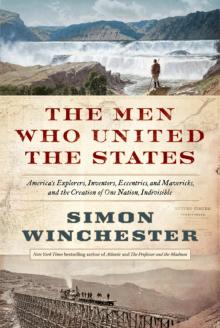 The Men Who United the States: America's Explorers
The Men Who United the States: America's Explorers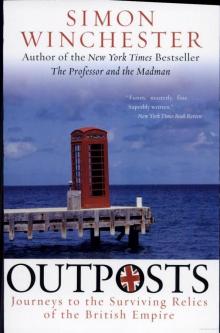 Outposts: Journeys to the Surviving Relics of the British Empire
Outposts: Journeys to the Surviving Relics of the British Empire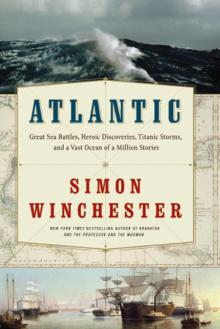 Atlantic: Great Sea Battles, Heroic Discoveries, Titanic Storms
Atlantic: Great Sea Battles, Heroic Discoveries, Titanic Storms The Professor and the Madman: A Tale of Murder, Insanity
The Professor and the Madman: A Tale of Murder, Insanity A Crack in the Edge of the World
A Crack in the Edge of the World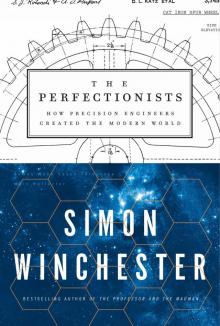 The Perfectionists: How Precision Engineers Created the Modern World
The Perfectionists: How Precision Engineers Created the Modern World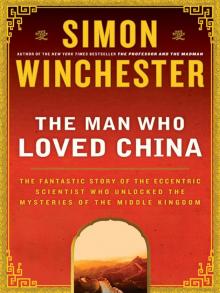 The Man Who Loved China: The Fantastic Story of the Eccentric Scientist
The Man Who Loved China: The Fantastic Story of the Eccentric Scientist The River at the Center of the World: A Journey Up the Yangtze
The River at the Center of the World: A Journey Up the Yangtze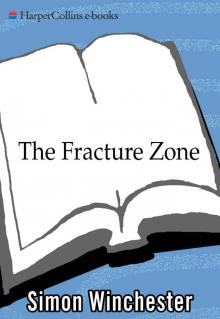 The Fracture Zone: My Return to the Balkans
The Fracture Zone: My Return to the Balkans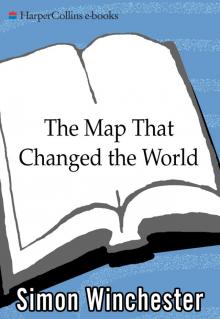 The Map That Changed the World
The Map That Changed the World Krakatoa: The Day the World Exploded
Krakatoa: The Day the World Exploded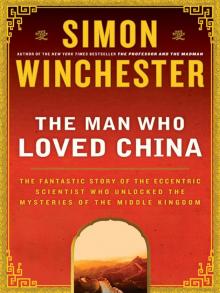 The Man Who Loved China
The Man Who Loved China The River at the Centre of the World
The River at the Centre of the World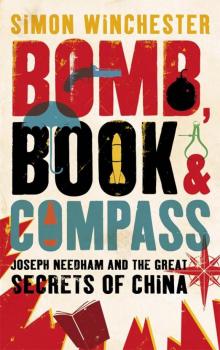 Bomb, Book and Compass
Bomb, Book and Compass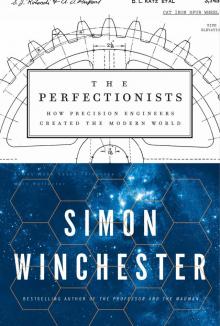 The Perfectionists
The Perfectionists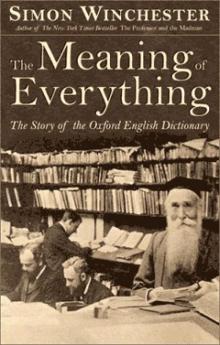 The Meaning of Everything
The Meaning of Everything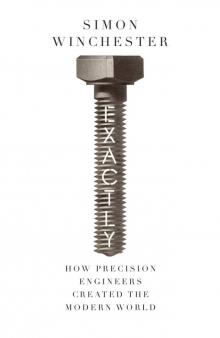 Exactly
Exactly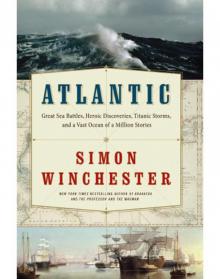 Atlantic
Atlantic Korea
Korea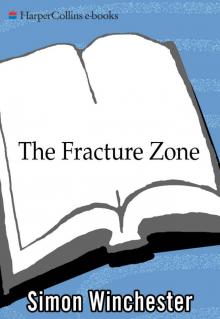 The Fracture Zone
The Fracture Zone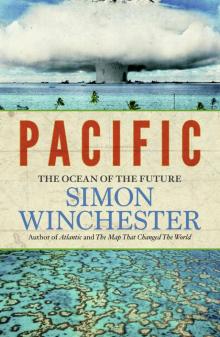 Pacific
Pacific Krakatoa
Krakatoa The Professor and the Madman
The Professor and the Madman Outposts
Outposts